Media | Articles
5 classic automotive comics that you can read for free
You say you’ve watched more automotive movies and videos than you can count? Read more books than a librarian? Built so many Lego cars that your house is beginning to look like a miniature dealership? When it comes to entertaining ways to pass the time while obediently observing the stay-at-home rules, how ’bout some car-related comic books that you download to your computer and read for free?
Comic Book Plus, which has been providing “free and legal” virtual comic books, comic strips, fanzines, British story papers, old-time radio, pulp fiction pamphlets, compilations, newspapers, and magazines since 2006, has hundreds and hundreds of options—including 14 titles and 195 issues in its Automotive Category.
Below are some that caught our eye.
Gasoline Alley (1918–present)
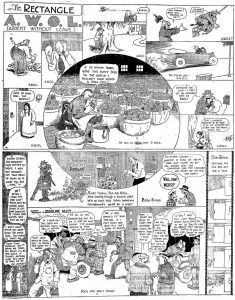
According to Comic Book Plus, Gasoline Alley made a low-key debut in The Chicago Tribune Syndicate on November 24, 1918, and it is still being published today. It is credited as the first comic strip in which the characters age normally, and it is also one of the first soap operas in any medium.
The strip was created by Frank King, who was asked to create a strip to appeal to the new generation of car owners and mechanics. Major characters include Walt Wallet, a car fanatic, head of the family and the strip’s central character; Phyllis Wallet, who married Walt on June 24, 1926 and died on April 26, 2004; Skeezix Wallet, Walt’s adopted son, who Walt found on his doorstep February 14, 1921; Avery, Walt’s cantankerous neighbor; and Pert, a rich miser and often the villain in the story.
Marketplace
Buy and sell classics with confidence
There are 14 issues of Gasoline Alley on the website, ranging from 1918–30.
Hot Rods and Racing Cars (1951–73)
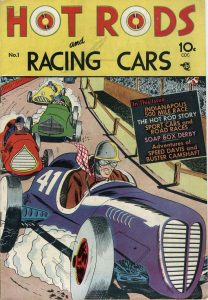
Although Comic Book Plus admits Hot Rods and Racing Cars is “not in the same league as Gasoline Alley, it showed considerable staying power.” Published by Charlton Comics Group, it ran from November 1951 to June 1973, with a total of 120 issues.
If you try one and fall in love with the series, you’ll be busy for a while. There are 89 issues of Hot Rods and Racing Cars available on the website, dating from 1951–67.
Charlton also published other car-related titles that can be found on Comic Book Plus, including Speed Demons (six issues, 1957–58), Hot Rod Racers (15 issues, 1964–67), Drag-Strip Hotrodders (17 issues, 1963–67), Teenage Hotrodders (24 issues, 1963–67), Grand Prix (two issues, 1967), Top Eliminator (two issues, 1967); and World of Wheels (two issues, 1967).
Hot Rod Comics (1952–53)
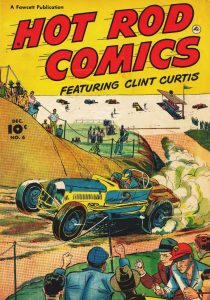
Produced by Fawcett Publications, Hot Rod Comics (featuring Clint Curtis) promoted safety and consideration of others to help promote the sport of “healthy” hot-rodding and change negative public perception. The December 1952 issue had this disclaimer up front, with plenty of exclamation points and in all caps, as is comic book style:
“Hot rods, like motorcycles and airplanes, are inclined to be fast and noisy! And, like motorcycles and airplanes, they generally get the cold-eye from a misunderstanding public! The minute any incident occurs, the public is out to squash them! So the rodder who really believes in hot-rodding as an educational sport must cooperate with the public if he wants to earn the respect he deserves!!”
Hot Rod and Speedway (1952–53)
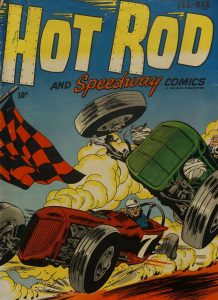
You get a different feeling from Hot Rod and Speedway, published by Hillman Periodicals, which begins… “Bill Spang, Hot-Rodder, tangles with the Chicken Driver… The screwball menace whose needled bucket came right down the middle of the road… and always fast!!!”
On the bright side, all’s well that ends well. Plus, at the conclusion of the story there are several pages of advertising, so you can score a “Super Special Quality” pseudo diamond ring for $4.95, learn to play guitar for only $1.69, and allow Charles Atlas to “make you a new man in only 15 minutes a day”… for free!
Tommy Gets the Keys (1960)
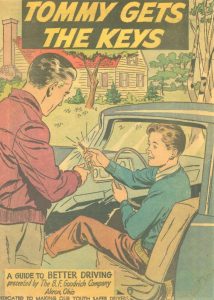
Finally, there’s this. Tommy Gets the Keys, published in 1960 by the B.F. Goodrich, is described as a “A Guide to Better Driving.” So we just had to read it—both because we can always use driving tips and because we wondered how hokey those lessons would be.
The story begins with Tommy Johnson and his family attending a race won by Skip Morgan, “the best driver in the country!” Tommy suggests, “I’d like to meet him… maybe he could give me some tips on how to be a racing driver.” Since it’s 1960, dear ol’ Dad sends wife Martha and daughter Betty to the parking lot—via a short-cut that will “save you trouble getting through the crowd”—while the men go off to meet the new stock-car racing champion. Tommy finds out that not only does his father know Skip Morgan personally, Skip’s parents live three houses down the street from the Johnsons. (How is it that Ed never shared this info with Tommy before?)
Shortly after Morgan shares some of his driving knowledge, Dad is forced to put it to use when a carload of crazy kids nearly runs the Johnsons off the road. Later, Martha voices her concern about Tommy getting his license. Dad picks up the phone and asks Skip Morgan to teach Tommy and his sister to drive. Tommy is disappointed to learn that Skip isn’t a lead foot off the track, but Skip says it’s the safest way to drive.
There are some hokey lines—hey, this is a comic book—but it’s actually a pretty helpful guide for our young drivers. And yes, Tommy passes his drivers test.
“You know, Skip, I was just thinking that Dad gave Tommy the keys to the car,” Betty says, “but you gave him the ‘keys’ to good driving!”
“Thanks, Betty—I only wish every young person could be given the opportunity to learn to be a good driver!”
They have!! Through Comic Book Plus!!!! Was that too many exclamation points? Maybe it should have been written in ALL CAPS…






